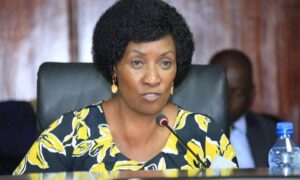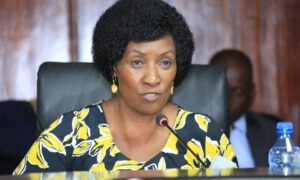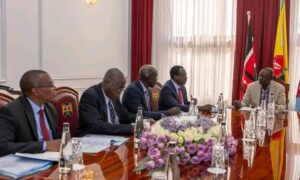In compliance with Section 101(y) of the Petroleum Act 2019 and Legal Notice No.192 of 2022, the Energy & Petroleum Regulatory Authority (EPRA) has announced a reduction in the maximum retail prices of petroleum products in Kenya for the period spanning from 15th February to 14th March 2024.
The new pricing structure reflects a noteworthy decrease in the maximum allowed petroleum pump prices for Super Petrol, Diesel, and Kerosene, each experiencing a reduction of KShs. 1.00 per litre. This adjustment is part of EPRA’s commitment to ensuring fair and transparent pricing in the petroleum sector.
These revised prices, inclusive of the 16% Value Added Tax (VAT), align with the provisions outlined in the Finance Act 2023, the Tax Laws (Amendment) Act 2020, and the updated rates for excise duty adjusted for inflation, as per Legal Notice No. 194 of 2020.
The basis for these changes lies in the fluctuation of the average landed cost of imported petroleum products. According to EPRA’s calculations, the average landed cost of Super Petrol decreased by 1.71% from US$677.78 per cubic meter in December 2023 to US$666.16 per cubic meter in January 2024. Similarly, Diesel experienced a 3.08% reduction, dropping from US$751.15 to US$728.03 per cubic meter during the same period. Kerosene followed suit with a 1.17% decrease, moving from US$727.00 to US$718.51 per cubic meter.
Table 1 provides a summarized overview of the changes in the landed costs:
| Prodict | Dec-23 US$/Cubic Metre | JAN-24 (US$/Cubic Metre | CHANGE |
| Super Petrol | 677.78 | 666.16 | -1.71% |
| Diesel | 751.15 | 728.03 | -3.08% |
| Kerosene | 727.00 | 718.51 | -1.17% |
The decrease in landed costs is attributed to various factors, including fluctuations in international market prices and changes in the global economic landscape.
Consumers can expect a positive impact on their budgets as these reductions in landed costs translate into lower pump prices at gas stations across the country. The move is anticipated to ease the financial burden on households and businesses, particularly those heavily reliant on transportation and energy for their day-to-day activities.
EPRA emphasizes its commitment to regular reviews of petroleum prices, ensuring that adjustments are made in response to market dynamics while adhering to legal frameworks governing the petroleum sector. The transparency in the pricing mechanism is aimed at fostering a competitive and fair environment within the industry.
As Kenyan motorists and businesses brace for the implementation of these new rates on 15th February 2024, the reduced pump prices are poised to provide a welcome respite amid economic challenges. The nation will be closely monitoring the petroleum sector’s responsiveness to these adjustments and their broader impact on the economy.
International Petroleum Market Trends Impacting Kenya’s Pump Prices.
Kenya, heavily reliant on imported refined petroleum products, witnesses fluctuations in pump prices driven by global market dynamics. The pricing benchmark provided by S&P Global Platts guides the international trade of Super Petrol, Diesel, and Kerosene. Table 2 highlights the trend of these prices in US$/MT over the past months.
| Month | Super Petrol | Diesel | Kerosene |
| Feb-23 | 830.68 | 755.71 | 718.68 |
| 68 Mar-23 | 842.11 | 865.47 | 674.48 |
| 48 Apr-23 | 820.41 | 754.35 | 736.63 |
| 63 May-23 | 785.96 | 818.01 | 609.35 |
| 35 Jun-23 | 820.41 | 754.35 | 736.63 |
Additionally, the exchange rate plays a crucial role in determining local pump prices. Table 3 outlines the USD-KShs exchange rate trend over the past 12 months, emphasizing the influence of currency fluctuations during price calculations.
| Month | Exchange Rate |
| Feb-23 | 880.67 |
| Mar-23 | 947.97 |
| Apr-23 | 961.35 |
| May-23 | 804.16 |
| Jun-23 | 791.66 |
Furthermore, the cost of Murban Crude Oil, a key component in global petroleum markets, impacts pricing. Table 4 displays the trends in USD/Bbl over the past 12 months.
| Month | Murban Crude Oil Price (USD/Bbl |
| Feb-23 | 133.98 |
| Mar-23 | 139.61 |
| Apr-23 | 138.96 |
| May-23 | 141.39 |
| Jun-23 | 144.48 |
The fluctuations in international petroleum prices, coupled with changes in exchange rates and crude oil costs, contribute to the periodic adjustments in Kenya’s pump prices. Consumers in major towns can refer to Annex I for a summary of resultant retail prices. For a more detailed breakdown of cost items for retail prices in Nairobi, Annex II provides comprehensive information.
As Kenya navigates the intricacies of the global petroleum market, these insights into international trends underscore the complexity of factors influencing local pump prices. The Energy & Petroleum Regulatory Authority’s commitment to transparency remains crucial in ensuring informed decision-making for both consumers and industry stakeholders.
Government Intervenes to Stabilize Diesel and Kerosene Prices in Kenya.
In a strategic move to maintain stability in the fuel market, the Kenyan government has opted to cross-subsidize the price of Diesel with that of Super Petrol, while Kerosene prices remain fully stabilized. This initiative aims to address the under recovery of costs by Oil Marketing Companies (OMCs), ensuring that the financial burden is alleviated through the Petroleum Development Levy (PDL) Fund.
The Petroleum Pricing Regulations play a pivotal role in this process by capping the retail prices of petroleum products already within the country. This approach is designed to facilitate cost recovery related to importation and other prudently incurred expenses, all while safeguarding reasonable prices for consumers.
The specific decision to cross-subsidize Diesel with Super Petrol recognizes the interdependence of these fuel categories and seeks to create a balance that shields consumers from abrupt and potentially burdensome price fluctuations. Meanwhile, Kerosene, a crucial energy source for many households, will see stable prices, offering predictability for consumers.
Oil Marketing Companies, grappling with under-recovered costs, will find relief through the Petroleum Development Levy (PDL) Fund. This financial mechanism is instrumental in compensating OMCs for the disparities between market prices and the capped retail prices, demonstrating the government’s commitment to supporting the industry and maintaining a fair and competitive marketplace.
The Energy & Petroleum Regulatory Authority (EPRA) emphasizes its ongoing commitment to ensuring fair competition and protecting the interests of both consumers and investors within the energy and petroleum sectors. The regulatory body assures the public that these measures are in place to strike a delicate balance between economic viability for industry players and affordability for the end consumer.
As the government intervenes to stabilize fuel prices, the move reflects a broader commitment to fostering a resilient and sustainable energy sector. Consumers can expect continued efforts to maintain transparency, fair pricing, and a regulatory environment that encourages healthy competition. The assurance from EPRA underscores the importance of collaborative efforts between the government, industry stakeholders, and the public to navigate the complexities of the energy landscape in Kenya.























